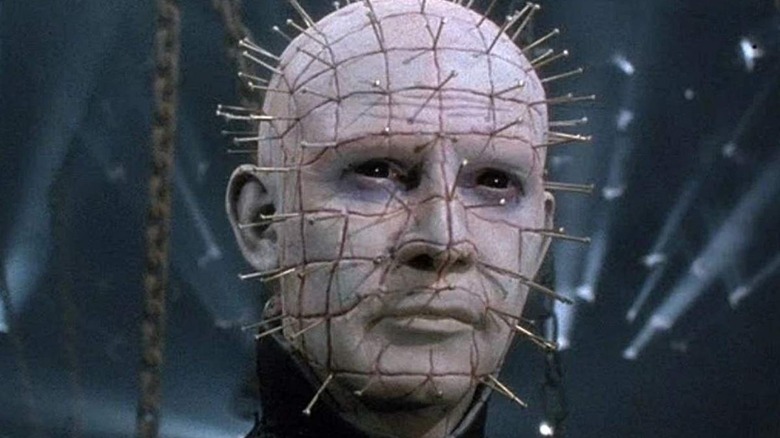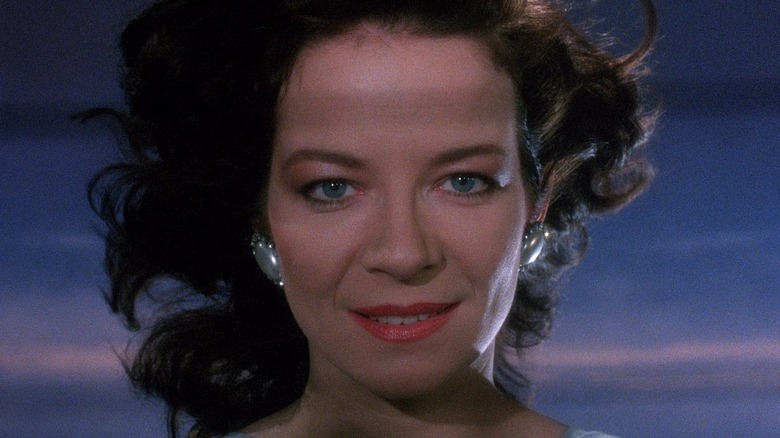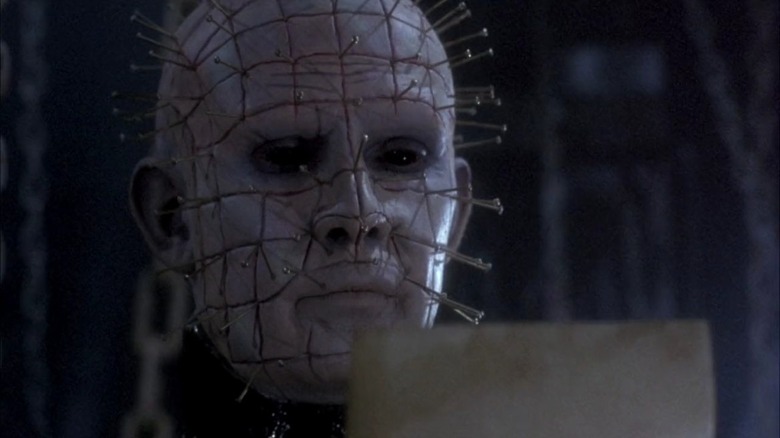The Ending Of Hellraiser 2 Explained
These days, the "Hellraiser" franchise has become a Frankenstein's monster of DTV efforts that began life as completely separate horror movies. According to Film School Rejects, elements of the mythology were shoehorned into unrelated scripts whenever Miramax needed to make sequels, and retain the rights to the series. Because of this, it's sometimes easy to forget that the early "Hellrasier" movies were actually quite ambitious — and had such sights to show us.
Clive Barker crafted the first "Hellraiser," based on his own novella "The Hellbound Heart," introducing terrified audiences to Pinhead (Doug Bradley) and the Cenobites in 1987. In the movie, Frank Cotton (Oliver Smith) escapes from the aforementioned demons' dimension and rekindles his relationship with his old flame, Julia (Clare Higgins), who helps him slaughter horny men and claim their flesh for his regeneration process. You know, normal couple activities. The film ends with the do-gooding Kirsty Cotton (Ashley Laurence) using the Lament Configuration — a mystical puzzle box that unleashes Hell — to summon the Cenobites and drag Frank back to the pit. Julia, meanwhile, dies on a mattress, but her journey is far from over.
"Hellbound: Hellraiser II" picks up immediately after those events, with Julia returning from the dead and seducing an occult-obsessed doctor who wants to see the labyrinth that is Hell for himself. What ensues is a mystery into the great unknown, as Hell is explored and the viewer learns more about Pinhead's history. This all leads to a horrific ending that ensures the nightmare will continue.
What's the deal with the Pillar of Souls at the end of Hellbound: Hellraiser II?
"Hellbound: Hellraiser II" ends with two moving men discovering the bloody mattress that Julia died on. In this universe, it's never a good idea to go near any surface that's associated with death, but one of the men does and is pulled in for his troubles. The other, meanwhile, looks on in amazement as the Pillar of Souls — a sculpture that's covered in the faces and bones of mutilated humans — emerges from the mattress. The pillar is essentially a prison for trapped souls of those who've been taken by the Cenobites throughout the years. Wherever it shows up, you can expect the forces of Hell to be close by.
The ending of "Hellbound: Hellraiser II" essentially sets up the return of Pinhead in the next installment. Though he is killed during the showdown with Dr. Channard (Kenneth Graham) earlier on, it goes without saying that horror franchises always find unique ways to bring their icons back. The Pillar of Souls plays a much larger role in "Hellraiser III: Hell On Earth," as it's revealed that Pinhead is trapped inside the sculpture. Fortunately, the well-spoken demon is able to manipulate some hedonistic schmuck into freeing him from the prison, so he can go on a destructive rampage in the human realm.
That being said, if the original plans of the filmmakers had come to fruition, the original ending of "Hellbound: Hellraiser II" would've played out quite differently — with Julia taking over as the new Queen of Hell, and becoming the primary villain of the series.
The ending of Hellbound: Hellraiser II suggests that the temptation will continue
The "Hellraiser" franchise has always been consistent in its pessimistic view of humanity. The foolish people who've intentionally sought out the Lament Configuration did so because they harbored nefarious desires that no earthly force could satisfy. For instance, Frank wanted to experience everything the world had to offer, especially when it came to sinful acts. Channard, on the other hand, craved power and knowledge of the universe's darkest secrets. Even though Kirsty wanted nothing to do with the Cenobites, her own curiosity upon discovering the puzzle box caused her to inadvertently summon them to her in the first place.
The closing moments of "Hellbound: Hellraiser II" feature a cameo from Little John, a vagrant who was introduced in the first film as a guardian of the Lament Configuration. He's the guy who turned into a dragon at the end of the movie, proving that appearances can be deceptive.
Upon laying his eyes on the scared moving man in "Hellbound: Hellraiser II," Little John asks the question that has befallen countless people throughout history: "What is your pleasure, sir?" The film ends on an ambiguous note, but Little John's cameo indicates that the cycle of temptation, pleasure, pain and suffering will continue, regardless of which specific Cenobites populate Hell. And it will be legendary.


